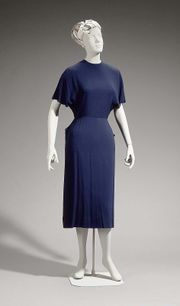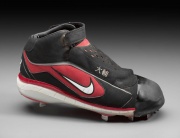Synthetic fiber
Jump to navigation
Jump to search
Description
Fibers manufactured from substances that have been produced or modified by chemical reactions. Artificial fibers were first made in 1842 when molten glass was formed into filaments. By the late 1880s, man-made fabrics were being made from Cellulose nitrate and rayon fibers. Current examples include: acetate, acrylic, alginic, anidex, aramid, azlon, casein, cupro, nylon, novoloid, nytril, modacrylic, modal, olefin, polyester, saran, spandex, Sulfar, triacetate, vinal, and vinyon.
Properties of Synthetic Fibers (Part 1)
| Fiber | Composition | Development date | Common trade name | Density | Denier (g/9000m) | Tenacity (g/denier) | Elongation at break (%) | Initial modulus | Moisture regain (%) | ||
|---|---|---|---|---|---|---|---|---|---|---|---|
| acetate | cellulose triacetate | 1919 | Celanese; Arnel; Tenite |
1.25-1.35 | 1.1-1.4 (dry); 0.65- 0.75 wet) |
25-35 (dry); 35-45 (wet) |
35-40 | 6.5 | |||
| acrylic | >85% acrylonitrile | 1950 | Acrilan, Creslan, Courtelle, Orlon | 1.16-1.18 | 2-8 | 2-3.6 (dry) | 20-55 | 25-63 | 1.0-3.0 | ||
| aramid (meta) | poly-m-phenylene terephthalamide | Nomex, Conex | 1.38 | 2-5 | 3-6 | 2-30 | 130-150 | 3.5 | |||
| aramid (para) | poly-p-phenylene terephthalamide | 1965 | Kevlar | 1.44 | 1.0-1.5 | 25-30 | 3-6 | 500- 1000 |
7.0 | ||
| azlon | protein | 1930s | Aralac, Ardil, Lanital | 1.25-1.3 | 0.9-1.1 (dry); 0.3- 0.6 (wet) |
60-70 | 14 | ||||
| modacrylic | 35-85% acrylonitrile | 1949 | Dynel; Verel, SEF | 1.35-1.37 | 2-8 | 1.8-2.5 (dry); 1.7- 2.4 (wet) |
35-48 | 25-56 | 0.4-4.0 | ||
| nylon 6 | polycaprolactam | 1939 | Perlon; Kapron, Power silk | 1.14 | 1.5-5 | 3.8-8.3 (dry); 3.5- 7.1 (wet) |
16-50 (dry); 19-55 (wet) |
25-35 | 3.5-5.0 | ||
| nylon 6,6 | polyhexamethylene adipamide | 1935 | Fiber 66; Antron; Stainmaster | 1.14 | 1.5-5 | 4.6-9.0 (dry); 4.0- 7.7 (wet) |
19-40% (dry); 32- 46% (wet) |
33-46 | 3.8-4.5 | ||
| nytril | >85% vinylidene dintrile | 1955; discontinued in 1970s |
Darvan | 1.18 | 2.0 (dry); 1.7 (wet) |
30 | 2-3 | ||||
| polyester | polyester terephthalate | 1941 | Dacron, Terylene; Hollytex | 1.5-5 | 2.2-9.5 | 10-50 | 25-50 | 0.1-0.4 | |||
| polyethylene | high density polyethylene | 1954 | Tyvek; Reevon | 0.95-0.96 | 2-10 | 5.0-8.0 | 14-20 | <0.1 | |||
| polypropylene | polypropylene | 1957 | Herculon, Marvess | 0.85-0.94 | 2-10 | 3.5-9.0 | 15-35 | 29-45 | <0.1 | ||
| polyurethane | >85%polyurethane | 1958 | spandex, Lycra | 1.20-1.25 | 2.5-20 | 0.5-1.5 | 500-700 | 0.3-1.2 | |||
| polyvinyl chloride | >85% vinyl chloride units | vinyon; Evilon, Thermovyl |
1.38-1.40 | 2.7-3.0 (wet or dry) |
12-20 | 0 | |||||
| rayon (cupro) | regenerated cellulose | 1890 | Cuprama; Cupresa | 1.54 | 2-3 | 1.7-2.3 (dry); 1.1- 1.135 (wet) |
10-17 (dry); 17-23 (wet) |
11-12.5 | |||
| rayon (viscose) | regenerated cellulose | 1892 | Avtex | 1.46-1.54 | 2-3 | 2.0-2.6 (wdry); 1.0- 1.5 (wet) |
13-15 (dry); 20-40 (wet) |
11-16.6 | |||
| vinal | >50% vinyl alcohol units | 1924 | Synthofil; Vinylon | 1.26-1.30 | 3.0 -8.5 (dry); 3.2- 7.6 (wet) |
9-26 (dry); 10-27 (wet) |
3.0-9.0 | ||||
Synonyms and Related Terms
synthetic fibers; man-made fiber; manmade fiber; man-made fibre; fibras sintéticas(Esp.)
For easy printing and to download
Properties of Synthetic Fibers
Resources and Citations
- Hoechst Celanese Corporation, Dictionary of Fiber & Textile Technology (older version called Man-made Fiber and Textile Dictionary, 1965), Hoechst Celanese Corporation, Charlotte NC, 1990
- Rosalie Rosso King, Textile Identification, Conservation, and Preservation, Noyes Publications, Park Ridge, NJ, 1985
- Marjory L. Joseph, Introductory Textile Science, Holt, Rinehart and Winston, Fort Worth, TX, 1986
- J.Gordon Cook, Handbook of Textile Fibres:II Man-made Fibres, Merrow Publishing Co. , Durham, England


